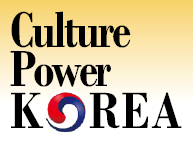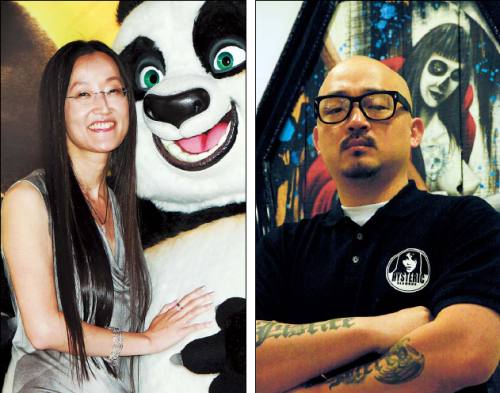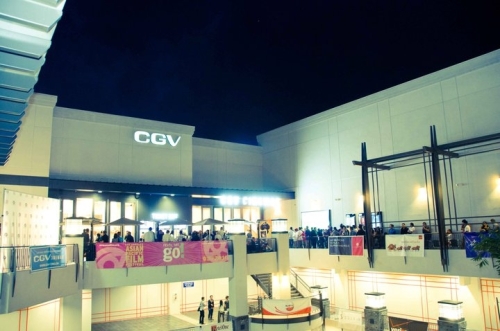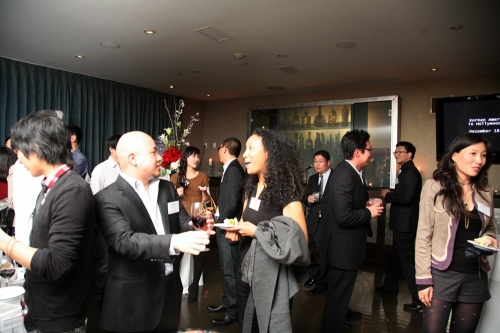Quality proven but without vital connections, Korean films struggle to crack Hollywood
LOS ANGELES ― Cinema 2 of CGV in Los Angeles, U.S., was a full house on the night of the sneak preview of the South Korean movie “Late Autumn” this month. The English-speaking audience, about 70 percent of whom had Asian features, laughed and sniffled their way through the two-hour movie starring Korean heartthrob Hyun Bin and Chinese actress Tang Wei.

“Seven years ago I was here having dinner at Uraeok and was looking for a project that would bring together Asian casts that can work in the American market. It is very refreshing to finally see the movie in the U.S. I think it was a very good idea to produce this kind of international movie,” Lee Joo-ick, CEO of Boram Entertainment, the producer of the movie, said after the screening.
The screening was part of the 2011 Los Angeles Asian Pacific Film Festival, established in 1983. This year it featured 180 films from 22 Asian countries.
Yoon Shinae, executive director of festival organizer Visual Communications, told The Korea Herald that she expects more Korean movies to participate in the festival in future.
“Korean movies have very good quality and the Korean movie industry has a big impact,” said the Korean-American director.
Korean films in top form
It has just been a dream for a long time, for Korean filmmakers to take their works to Hollywood. Well, the dream is finally coming true for some.
Park Chan-wook, director of “Oldboy,” will start shooting his new movie “Stoker” in the U.S. this summer. British actor Colin Firth and Hollywood actresses Nicole Kidman and Mia Wasikowska will be starring in the movie planned for release in 2012. Park has been focusing on a Hollywood debut since his last feature-length film, “Thirst” (2009).
Director Kim Ji-woon of “I Saw the Devil” is also looking forward to a Hollywood debut next year with his new movie “The Last Stand.” Arnold Schwarzenegger is considering taking the main role.
Korean graphic artist Hyung Min-woo’s popular comic series “Priest” has been made into a 3-D Hollywood movie of the same name. Directed by Scott Stewart, the science fiction thriller about an alternative world ravaged by war between men and vampires was released in the U.S. on May 13 and will be released in Korea on June 9.
Other movies that have recently excited Korean movie insiders include “Hello Ghost,” a 2010 movie which will be remade in Hollywood by Chris Columbus, director of the Home Alone movies and the first two Harry Potter films, and Dream Works animation film “Kung Fu Panda 2” whose director, Jennifer Yuh, is a Korean-American.
“They (Korean filmmakers and writers) are now in their tip-top condition,” said Kim Young, Senior Vice President of CGV America Holding’s Strategic Management & Operations.
LOS ANGELES ― Cinema 2 of CGV in Los Angeles, U.S., was a full house on the night of the sneak preview of the South Korean movie “Late Autumn” this month. The English-speaking audience, about 70 percent of whom had Asian features, laughed and sniffled their way through the two-hour movie starring Korean heartthrob Hyun Bin and Chinese actress Tang Wei.

“Seven years ago I was here having dinner at Uraeok and was looking for a project that would bring together Asian casts that can work in the American market. It is very refreshing to finally see the movie in the U.S. I think it was a very good idea to produce this kind of international movie,” Lee Joo-ick, CEO of Boram Entertainment, the producer of the movie, said after the screening.
The screening was part of the 2011 Los Angeles Asian Pacific Film Festival, established in 1983. This year it featured 180 films from 22 Asian countries.
Yoon Shinae, executive director of festival organizer Visual Communications, told The Korea Herald that she expects more Korean movies to participate in the festival in future.
“Korean movies have very good quality and the Korean movie industry has a big impact,” said the Korean-American director.
Korean films in top form
It has just been a dream for a long time, for Korean filmmakers to take their works to Hollywood. Well, the dream is finally coming true for some.
Park Chan-wook, director of “Oldboy,” will start shooting his new movie “Stoker” in the U.S. this summer. British actor Colin Firth and Hollywood actresses Nicole Kidman and Mia Wasikowska will be starring in the movie planned for release in 2012. Park has been focusing on a Hollywood debut since his last feature-length film, “Thirst” (2009).
Director Kim Ji-woon of “I Saw the Devil” is also looking forward to a Hollywood debut next year with his new movie “The Last Stand.” Arnold Schwarzenegger is considering taking the main role.
Korean graphic artist Hyung Min-woo’s popular comic series “Priest” has been made into a 3-D Hollywood movie of the same name. Directed by Scott Stewart, the science fiction thriller about an alternative world ravaged by war between men and vampires was released in the U.S. on May 13 and will be released in Korea on June 9.
Other movies that have recently excited Korean movie insiders include “Hello Ghost,” a 2010 movie which will be remade in Hollywood by Chris Columbus, director of the Home Alone movies and the first two Harry Potter films, and Dream Works animation film “Kung Fu Panda 2” whose director, Jennifer Yuh, is a Korean-American.
“They (Korean filmmakers and writers) are now in their tip-top condition,” said Kim Young, Senior Vice President of CGV America Holding’s Strategic Management & Operations.

CGV L.A., the first-ever Korean movie theater to have opened in the U.S., is playing its part to promote Korean movies there. It showcases Korean films with English subtitles and U.S. films with Korean subtitles and over 100,000 have visited the movie theater since its opening in June 2010.
The movie theater is located in a small shopping mall, “Madang the Courtyard,” in Korea Town, which houses Korean restaurants, shops and beauty salons. Though the mall was not yet fully leased out, CGV L.A. was crowded with visitors during the film festival.

“The ratio of audience’s ethnicity is very content-driven. When we were showing “Detective K,” and “Last Godfather,” 85 percent of the audience were Korean but when we showed “Fast Five,” 55 percent were Korean. We want that 50-50 mix,” said Martin Kim, Marketing Manager at CJ Entertainment America.
Hosting the film festival was another way to get closer to the international audience.
“It is not just to show it to Korean people but we want to share it with non-Koreans and help them understand the culture,” said Kim.
Kim said that CGV L.A. has the competence to grow even though the whole U.S. movie theater industry has shrunk about 20 percent due to the development of digital and online channels and various devices like Blue Ray.
“What is different with us is that we offer different contents ― special and different Korean movies. And we offer theaters with stadium sitting and assigned seats which is not so common in the U.S.,” said Kim. Korean drinks in its caf, like “misutgaru,” or mixed grain powder, smoothies are popular among non-Korean visitors too.
‘How to show it’
Overshadowed by the few successes are the still many more Korean films and directors who failed or never even tried in Hollywood.
A recent example is Korean comedian/director Shim Hyung-rae’s “Last Godfather” which had heightened media interest for being his second Hollywood production attempt, but ended a failure. It was released in 58 theaters in North America earlier this year but the number dropped to one theater within only 15 days. It earned about $155,000 during the screening.
“The production cost was too big to start with, and there were too few screens. Besides, comedy seems to be the most difficult genre for people from other cultures to understand,” said Koo Kyoung-bon, director of Korea Creative Content Agency USA.
KOCCA set up its L.A. branch in 2004 to arrange networking opportunities for those in Korea’s movie industry with the U.S. entertainment business figures and to consult and support Korean companies that wish to advance into the U.S. market. KOCCA spent 1.2 billion won to support the production of “Last Godfather.”
“Some ask why we supported the movie among many that tryout for Hollywood. But although there are many directors who say that they want to try out here, not many actually make the movies to do so,” added Koo.
Some also mention that the haughty manners of some Korean directors are a big obstacle for bringing Korean movies to Hollywood.
“When you make movies, you want famous directors. But they (famous Korean directors) are used to getting all the privileges in Korea and if we try to bring them in that way, not many investors can afford the money. So it is hard to convince them to come here without getting the privileges,” said an official at a top U.S. movie production house.
Inefficient efforts made by some Korean filmmakers and distributors are also a problem. Hwang Soo-jin, manager of KOFIC USA, said that many show weakness when it comes to actually dealing and looking at legal procedures. So when she came to the office last year, she decided to “promote Korean involvement in U.S. film productions as well as actually promoting Korean films.”
“They seem to be willing to do anything when it comes to Hollywood. But Koreans simply boast that they have the money but never really show how smartly it could be used. They have to realize that while some deals are right for them, some are just not. We find appropriate business matches for them,” said Hwang Soo-jin, manager of KOFIC USA.
While Korean distributors long to ink deals with U.S. distributors, CGV L.A. faces problems because they cannot get English subtitles. Although one of the biggest purposes of the theater is to provide English-language subtitles for Korean films and widen the audience for Korean films, there were times when it screened them without subtitles.
“Korean film distributors don’t want to send English subtitles because they want to sell the films to U.S. distributors. When that does not work out, then they send it here, but by then, the movie is already down in theaters in Korea. If we make the subtitles ourselves, it costs about $3,000 to $4,000,” said Martin Kim.
But the biggest obstacle for Korean films to advance into Hollywood is that the U.S. movie industry is largely based on personal networks.
“It won’t work, trying to work something out by bringing money here ― Hollywood is not a place lacking money. Though it seems to be the slowest way, the fastest way to do it right is to plant people. They trust friends who their trustworthy friends introduce. We should make the best use of Korean-Americans who have already settled down in the industry,” said Kim Jae-won, Director/Consul at the Korean Cultural Center in L.A.

KOCCA L.A. initiated a mentoring program called “Korean Americans in Hollywood” last year to provide guidance to Koreans entering the Hollywood entertainment industry. It has held two workshops so far ― one in L.A. last August and one in Seoul last November ― and brought together several hundreds of participants. Last year’s mentors included already successful Korean American figures in U.S. showbiz like Keli Lee, executive vice president of ABC, and Roy Lee, producer at Vertigo Entertainment. This year’s mentors have not been decided yet.
Hwang also emphasized the importance of networking.
“Right now we promote Korean films to opinion leaders who are interested in them by emailing them about events. I hope that a proper venue could be prepared so that anyone in showbiz who is interested in Korean and U.S. film industries can gather there and network,” said Hwang.
By Park Min-young, Korea Herald correspondent
(claire@heraldcorp.com)
















![[KH Explains] Hyundai's full hybrid edge to pay off amid slow transition to pure EVs](http://res.heraldm.com/phpwas/restmb_idxmake.php?idx=652&simg=/content/image/2024/04/18/20240418050645_0.jpg&u=20240419100350)

![[Today’s K-pop] Zico drops snippet of collaboration with Jennie](http://res.heraldm.com/phpwas/restmb_idxmake.php?idx=642&simg=/content/image/2024/04/18/20240418050702_0.jpg&u=)